Singapore Market Entry Analysis: Brain Boost Energy Drink Report
VerifiedAdded on 2023/01/19
|20
|4778
|69
Report
AI Summary
This report provides a comprehensive market analysis of Singapore for the Brain Boost energy drink, examining various factors influencing its potential success. The analysis delves into economic factors, including GDP growth, per capita income, and unemployment rates, highlighting Singapore's strong free-market economy and competitive business environment. It then assesses political stability, government structure, and international relations, noting Singapore's low political risk. Legal considerations, such as e-commerce regulations and employment laws, are also evaluated. Furthermore, the report explores financial aspects, including the Singapore Dollar's strength and foreign exchange issues. The cultural landscape, including consumer preferences and market challenges, is also discussed. The report concludes with recommendations on the suitability of Singapore as a target market, considering the country's strategic location, economic strength, and business-friendly environment. The report is designed to provide key insights into the Singapore market to inform the decision-making process for the Brain Boost energy drink.
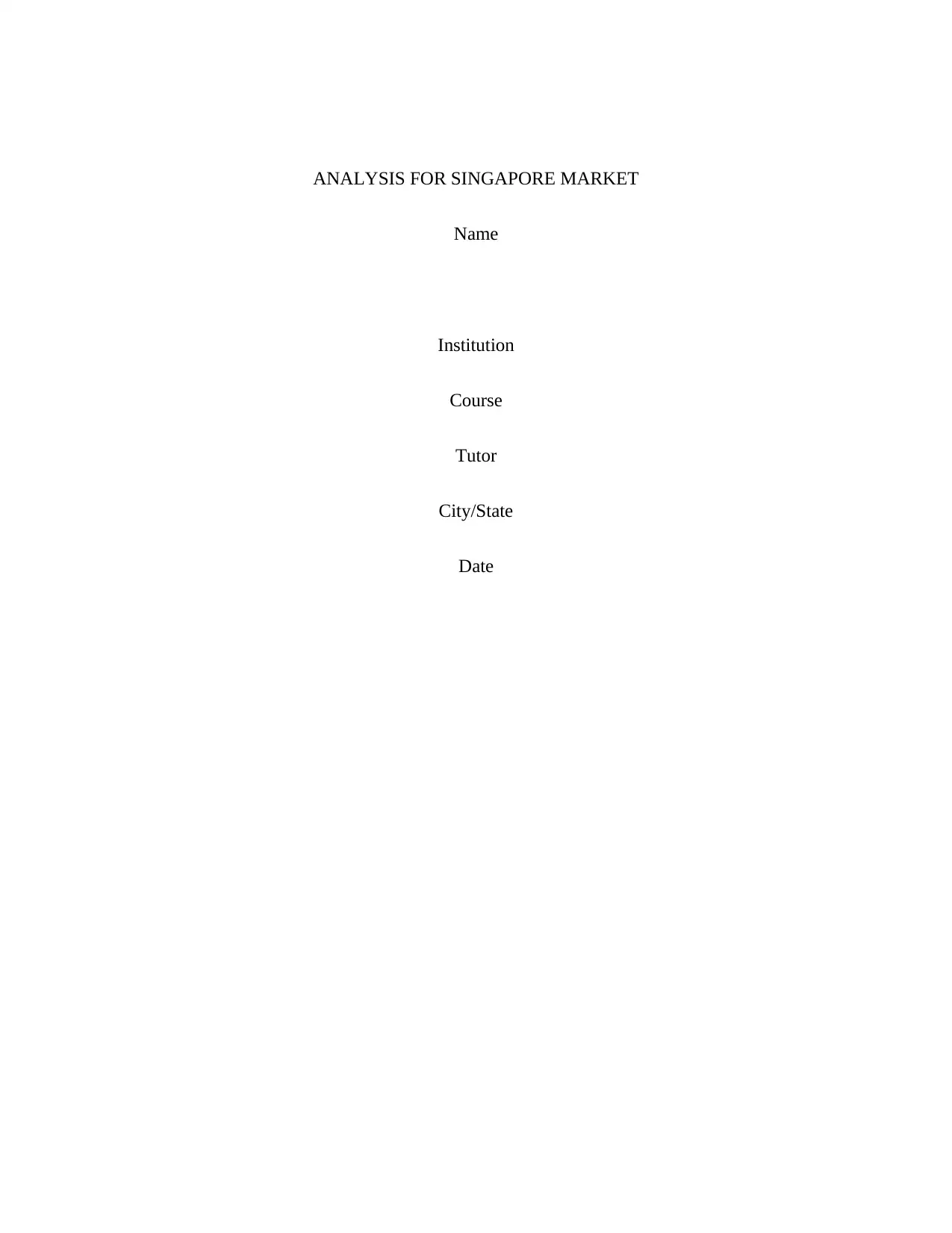
ANALYSIS FOR SINGAPORE MARKET
Name
Institution
Course
Tutor
City/State
Date
Name
Institution
Course
Tutor
City/State
Date
Paraphrase This Document
Need a fresh take? Get an instant paraphrase of this document with our AI Paraphraser
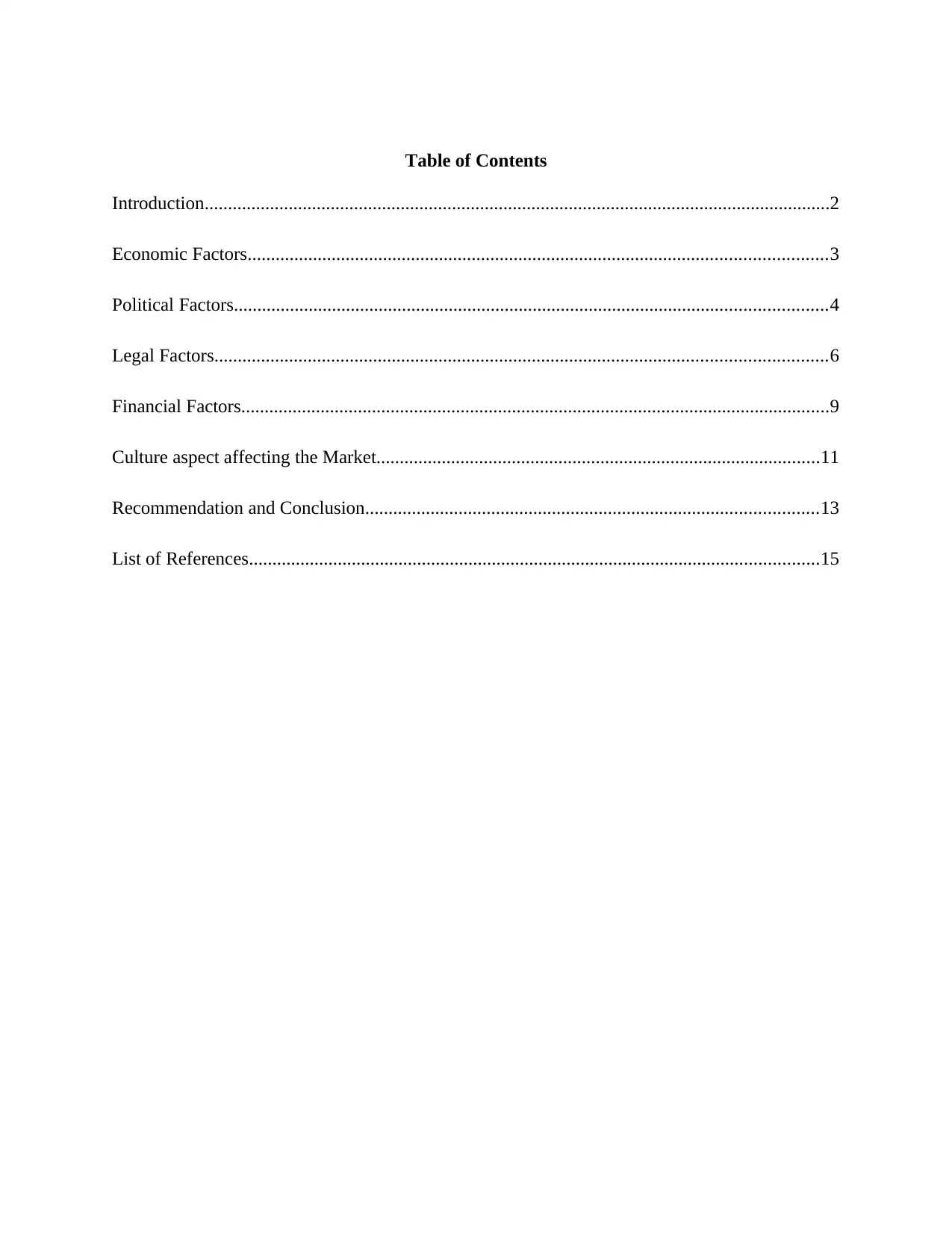
Table of Contents
Introduction......................................................................................................................................2
Economic Factors............................................................................................................................3
Political Factors...............................................................................................................................4
Legal Factors...................................................................................................................................6
Financial Factors..............................................................................................................................9
Culture aspect affecting the Market...............................................................................................11
Recommendation and Conclusion.................................................................................................13
List of References..........................................................................................................................15
Introduction......................................................................................................................................2
Economic Factors............................................................................................................................3
Political Factors...............................................................................................................................4
Legal Factors...................................................................................................................................6
Financial Factors..............................................................................................................................9
Culture aspect affecting the Market...............................................................................................11
Recommendation and Conclusion.................................................................................................13
List of References..........................................................................................................................15
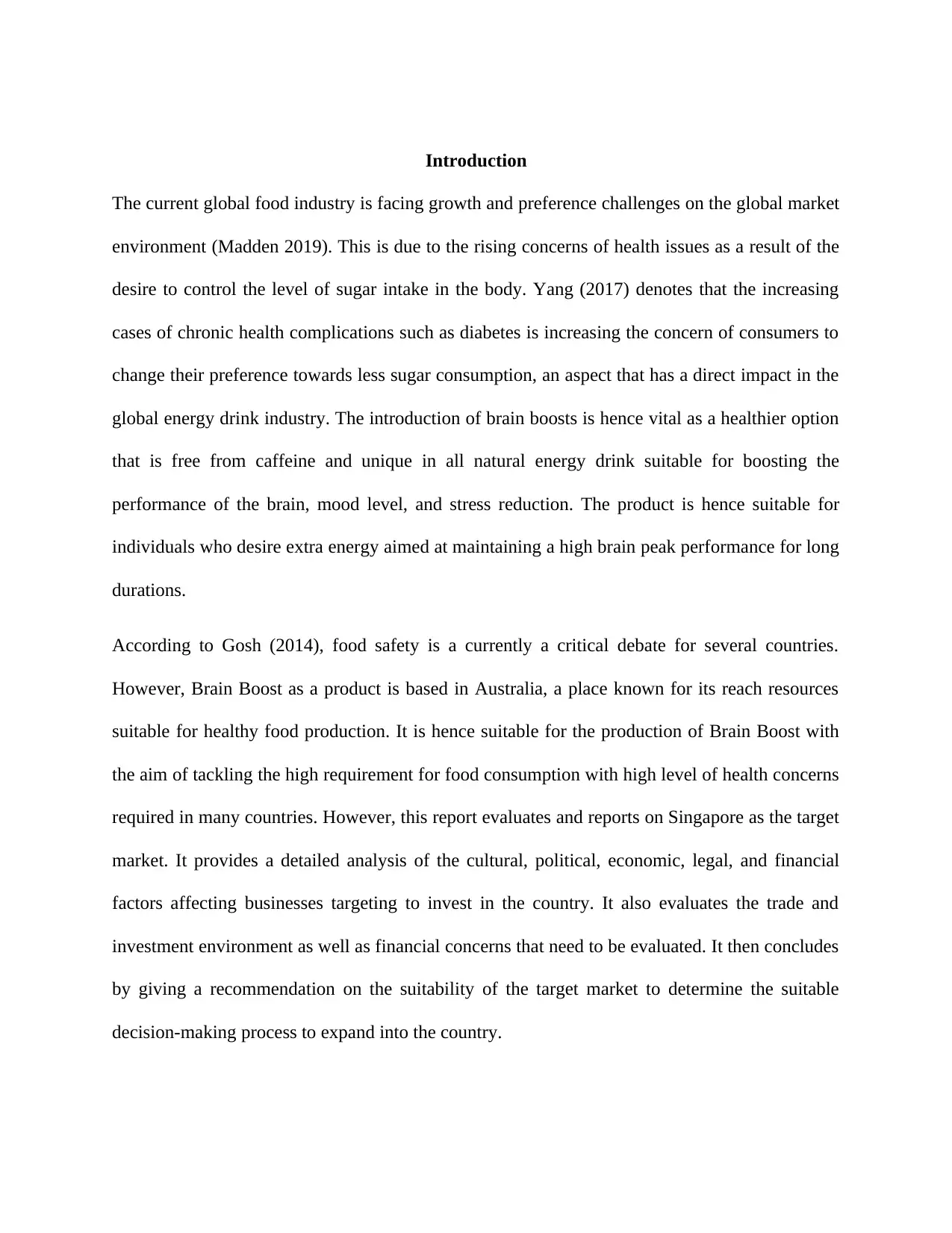
Introduction
The current global food industry is facing growth and preference challenges on the global market
environment (Madden 2019). This is due to the rising concerns of health issues as a result of the
desire to control the level of sugar intake in the body. Yang (2017) denotes that the increasing
cases of chronic health complications such as diabetes is increasing the concern of consumers to
change their preference towards less sugar consumption, an aspect that has a direct impact in the
global energy drink industry. The introduction of brain boosts is hence vital as a healthier option
that is free from caffeine and unique in all natural energy drink suitable for boosting the
performance of the brain, mood level, and stress reduction. The product is hence suitable for
individuals who desire extra energy aimed at maintaining a high brain peak performance for long
durations.
According to Gosh (2014), food safety is a currently a critical debate for several countries.
However, Brain Boost as a product is based in Australia, a place known for its reach resources
suitable for healthy food production. It is hence suitable for the production of Brain Boost with
the aim of tackling the high requirement for food consumption with high level of health concerns
required in many countries. However, this report evaluates and reports on Singapore as the target
market. It provides a detailed analysis of the cultural, political, economic, legal, and financial
factors affecting businesses targeting to invest in the country. It also evaluates the trade and
investment environment as well as financial concerns that need to be evaluated. It then concludes
by giving a recommendation on the suitability of the target market to determine the suitable
decision-making process to expand into the country.
The current global food industry is facing growth and preference challenges on the global market
environment (Madden 2019). This is due to the rising concerns of health issues as a result of the
desire to control the level of sugar intake in the body. Yang (2017) denotes that the increasing
cases of chronic health complications such as diabetes is increasing the concern of consumers to
change their preference towards less sugar consumption, an aspect that has a direct impact in the
global energy drink industry. The introduction of brain boosts is hence vital as a healthier option
that is free from caffeine and unique in all natural energy drink suitable for boosting the
performance of the brain, mood level, and stress reduction. The product is hence suitable for
individuals who desire extra energy aimed at maintaining a high brain peak performance for long
durations.
According to Gosh (2014), food safety is a currently a critical debate for several countries.
However, Brain Boost as a product is based in Australia, a place known for its reach resources
suitable for healthy food production. It is hence suitable for the production of Brain Boost with
the aim of tackling the high requirement for food consumption with high level of health concerns
required in many countries. However, this report evaluates and reports on Singapore as the target
market. It provides a detailed analysis of the cultural, political, economic, legal, and financial
factors affecting businesses targeting to invest in the country. It also evaluates the trade and
investment environment as well as financial concerns that need to be evaluated. It then concludes
by giving a recommendation on the suitability of the target market to determine the suitable
decision-making process to expand into the country.
⊘ This is a preview!⊘
Do you want full access?
Subscribe today to unlock all pages.

Trusted by 1+ million students worldwide
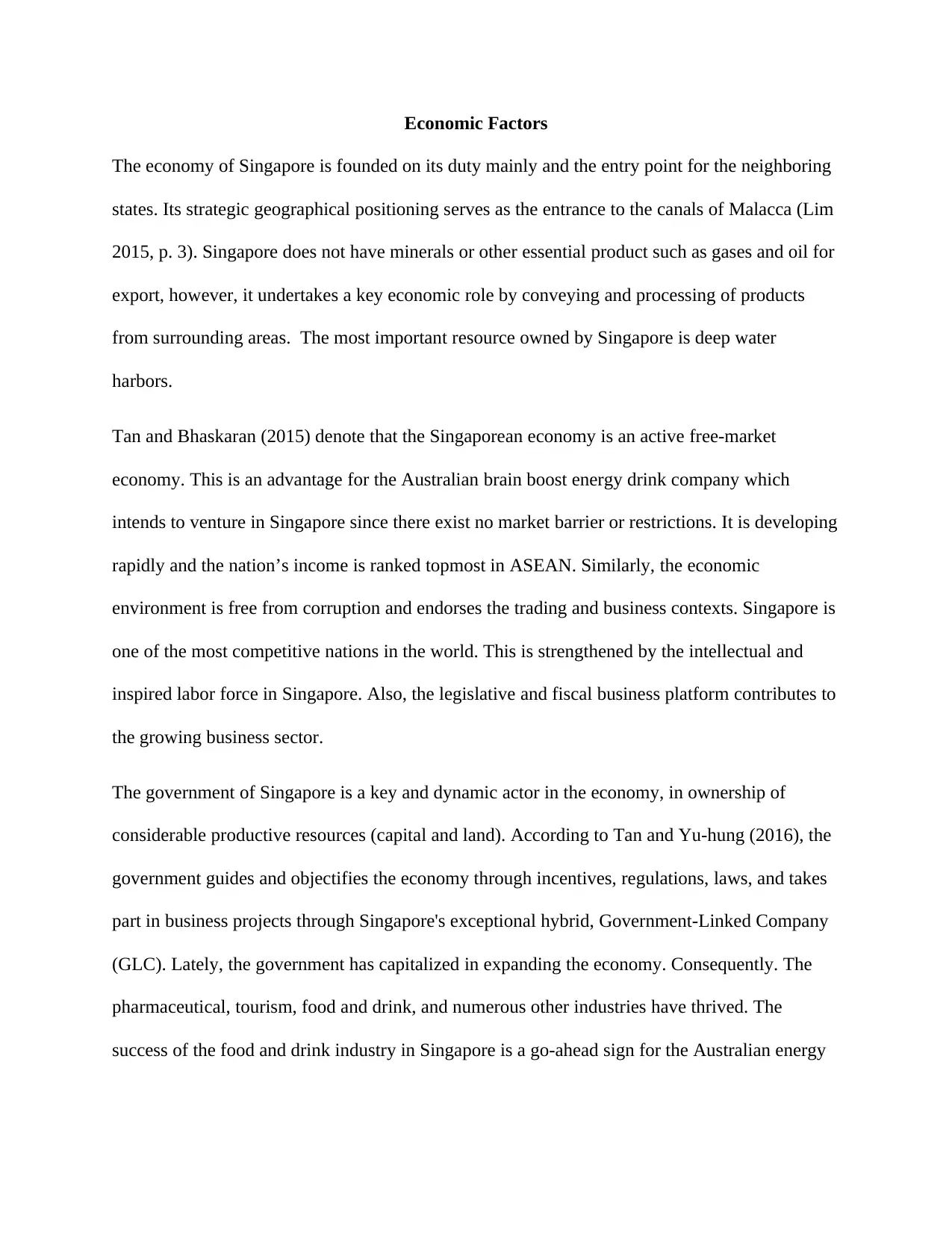
Economic Factors
The economy of Singapore is founded on its duty mainly and the entry point for the neighboring
states. Its strategic geographical positioning serves as the entrance to the canals of Malacca (Lim
2015, p. 3). Singapore does not have minerals or other essential product such as gases and oil for
export, however, it undertakes a key economic role by conveying and processing of products
from surrounding areas. The most important resource owned by Singapore is deep water
harbors.
Tan and Bhaskaran (2015) denote that the Singaporean economy is an active free-market
economy. This is an advantage for the Australian brain boost energy drink company which
intends to venture in Singapore since there exist no market barrier or restrictions. It is developing
rapidly and the nation’s income is ranked topmost in ASEAN. Similarly, the economic
environment is free from corruption and endorses the trading and business contexts. Singapore is
one of the most competitive nations in the world. This is strengthened by the intellectual and
inspired labor force in Singapore. Also, the legislative and fiscal business platform contributes to
the growing business sector.
The government of Singapore is a key and dynamic actor in the economy, in ownership of
considerable productive resources (capital and land). According to Tan and Yu-hung (2016), the
government guides and objectifies the economy through incentives, regulations, laws, and takes
part in business projects through Singapore's exceptional hybrid, Government-Linked Company
(GLC). Lately, the government has capitalized in expanding the economy. Consequently. The
pharmaceutical, tourism, food and drink, and numerous other industries have thrived. The
success of the food and drink industry in Singapore is a go-ahead sign for the Australian energy
The economy of Singapore is founded on its duty mainly and the entry point for the neighboring
states. Its strategic geographical positioning serves as the entrance to the canals of Malacca (Lim
2015, p. 3). Singapore does not have minerals or other essential product such as gases and oil for
export, however, it undertakes a key economic role by conveying and processing of products
from surrounding areas. The most important resource owned by Singapore is deep water
harbors.
Tan and Bhaskaran (2015) denote that the Singaporean economy is an active free-market
economy. This is an advantage for the Australian brain boost energy drink company which
intends to venture in Singapore since there exist no market barrier or restrictions. It is developing
rapidly and the nation’s income is ranked topmost in ASEAN. Similarly, the economic
environment is free from corruption and endorses the trading and business contexts. Singapore is
one of the most competitive nations in the world. This is strengthened by the intellectual and
inspired labor force in Singapore. Also, the legislative and fiscal business platform contributes to
the growing business sector.
The government of Singapore is a key and dynamic actor in the economy, in ownership of
considerable productive resources (capital and land). According to Tan and Yu-hung (2016), the
government guides and objectifies the economy through incentives, regulations, laws, and takes
part in business projects through Singapore's exceptional hybrid, Government-Linked Company
(GLC). Lately, the government has capitalized in expanding the economy. Consequently. The
pharmaceutical, tourism, food and drink, and numerous other industries have thrived. The
success of the food and drink industry in Singapore is a go-ahead sign for the Australian energy
Paraphrase This Document
Need a fresh take? Get an instant paraphrase of this document with our AI Paraphraser

drink company intending to set up business in Singapore. One of the major reasons behind the
accomplishment is its strategic geographical positioning.
Steered by the universal explosion in Information Technology (IT) demand and healthy salvages
in local consumption and venture, GDP growth stood at 10% in 2015 (Bhaskaran 2014, p. 293).
Studies have shown that Singapore’s thoughtfulness to the outside economic environment, with
business running nearly 300%, is extreme. There was no inflation in 2016, as consumer costs
exhibit slight deflation (-0.3% to -0.8%) in 2016. Unemployment rose to 4.6% in 2015 and
stayed above 3% in 2016, a great level for Singapore, therefore, if the Australian brain boost
energy drink company ventures in doing business in Singapore, it will create additional
employment opportunities. Per capita income approximate in regards to buying power was $23,
800, as it was the leading in the world economy at that period.
Lim (2015) assert that drawbacks on the Singaporean economic performance are shortages of
labor, increasing costs of labor, and the dropping of output; even though by the first and second
quarter of 2016, profits in output were leveraging 15.2% likened to declines leveraging 16.25%
in the last quarter of 2017. Singapore sustains one of the largest business regimes globally and
has often been ranked among the most competitive and least corrupt nations.
Political Factors
The Singaporean government is designed after the Westminster structure, with 3 distinct
divisions which are the executive, the judiciary and the legislature (Bal 2015, p. 231). The laws
of the nation are formulated by the legislature, administered by the executive, and interpreted by
the judiciary. The head of government in Singapore is the Prime Minister and the head of state is
the President. The Singaporean parliament has only one house since it is unicameral. The speaker
accomplishment is its strategic geographical positioning.
Steered by the universal explosion in Information Technology (IT) demand and healthy salvages
in local consumption and venture, GDP growth stood at 10% in 2015 (Bhaskaran 2014, p. 293).
Studies have shown that Singapore’s thoughtfulness to the outside economic environment, with
business running nearly 300%, is extreme. There was no inflation in 2016, as consumer costs
exhibit slight deflation (-0.3% to -0.8%) in 2016. Unemployment rose to 4.6% in 2015 and
stayed above 3% in 2016, a great level for Singapore, therefore, if the Australian brain boost
energy drink company ventures in doing business in Singapore, it will create additional
employment opportunities. Per capita income approximate in regards to buying power was $23,
800, as it was the leading in the world economy at that period.
Lim (2015) assert that drawbacks on the Singaporean economic performance are shortages of
labor, increasing costs of labor, and the dropping of output; even though by the first and second
quarter of 2016, profits in output were leveraging 15.2% likened to declines leveraging 16.25%
in the last quarter of 2017. Singapore sustains one of the largest business regimes globally and
has often been ranked among the most competitive and least corrupt nations.
Political Factors
The Singaporean government is designed after the Westminster structure, with 3 distinct
divisions which are the executive, the judiciary and the legislature (Bal 2015, p. 231). The laws
of the nation are formulated by the legislature, administered by the executive, and interpreted by
the judiciary. The head of government in Singapore is the Prime Minister and the head of state is
the President. The Singaporean parliament has only one house since it is unicameral. The speaker
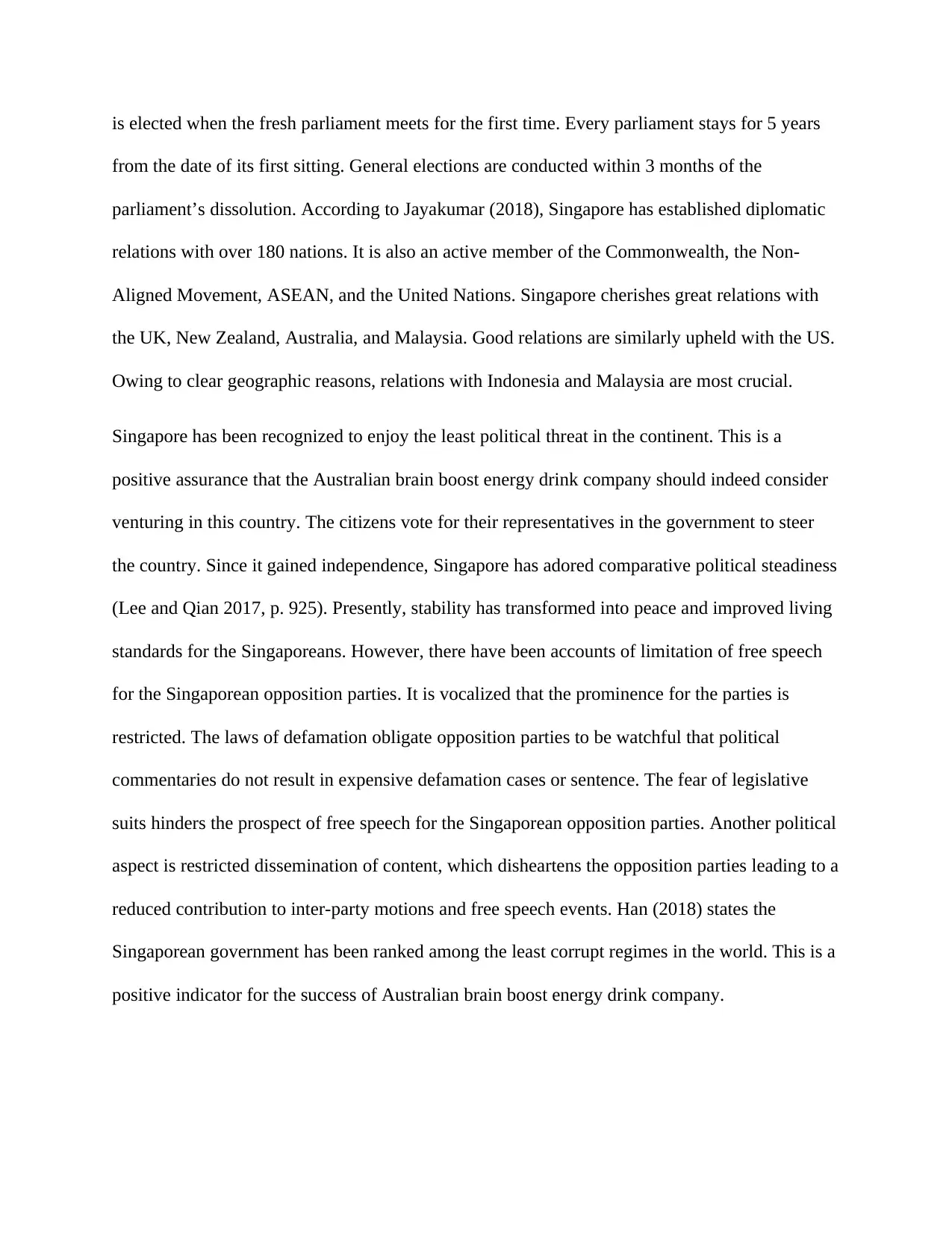
is elected when the fresh parliament meets for the first time. Every parliament stays for 5 years
from the date of its first sitting. General elections are conducted within 3 months of the
parliament’s dissolution. According to Jayakumar (2018), Singapore has established diplomatic
relations with over 180 nations. It is also an active member of the Commonwealth, the Non-
Aligned Movement, ASEAN, and the United Nations. Singapore cherishes great relations with
the UK, New Zealand, Australia, and Malaysia. Good relations are similarly upheld with the US.
Owing to clear geographic reasons, relations with Indonesia and Malaysia are most crucial.
Singapore has been recognized to enjoy the least political threat in the continent. This is a
positive assurance that the Australian brain boost energy drink company should indeed consider
venturing in this country. The citizens vote for their representatives in the government to steer
the country. Since it gained independence, Singapore has adored comparative political steadiness
(Lee and Qian 2017, p. 925). Presently, stability has transformed into peace and improved living
standards for the Singaporeans. However, there have been accounts of limitation of free speech
for the Singaporean opposition parties. It is vocalized that the prominence for the parties is
restricted. The laws of defamation obligate opposition parties to be watchful that political
commentaries do not result in expensive defamation cases or sentence. The fear of legislative
suits hinders the prospect of free speech for the Singaporean opposition parties. Another political
aspect is restricted dissemination of content, which disheartens the opposition parties leading to a
reduced contribution to inter-party motions and free speech events. Han (2018) states the
Singaporean government has been ranked among the least corrupt regimes in the world. This is a
positive indicator for the success of Australian brain boost energy drink company.
from the date of its first sitting. General elections are conducted within 3 months of the
parliament’s dissolution. According to Jayakumar (2018), Singapore has established diplomatic
relations with over 180 nations. It is also an active member of the Commonwealth, the Non-
Aligned Movement, ASEAN, and the United Nations. Singapore cherishes great relations with
the UK, New Zealand, Australia, and Malaysia. Good relations are similarly upheld with the US.
Owing to clear geographic reasons, relations with Indonesia and Malaysia are most crucial.
Singapore has been recognized to enjoy the least political threat in the continent. This is a
positive assurance that the Australian brain boost energy drink company should indeed consider
venturing in this country. The citizens vote for their representatives in the government to steer
the country. Since it gained independence, Singapore has adored comparative political steadiness
(Lee and Qian 2017, p. 925). Presently, stability has transformed into peace and improved living
standards for the Singaporeans. However, there have been accounts of limitation of free speech
for the Singaporean opposition parties. It is vocalized that the prominence for the parties is
restricted. The laws of defamation obligate opposition parties to be watchful that political
commentaries do not result in expensive defamation cases or sentence. The fear of legislative
suits hinders the prospect of free speech for the Singaporean opposition parties. Another political
aspect is restricted dissemination of content, which disheartens the opposition parties leading to a
reduced contribution to inter-party motions and free speech events. Han (2018) states the
Singaporean government has been ranked among the least corrupt regimes in the world. This is a
positive indicator for the success of Australian brain boost energy drink company.
⊘ This is a preview!⊘
Do you want full access?
Subscribe today to unlock all pages.

Trusted by 1+ million students worldwide
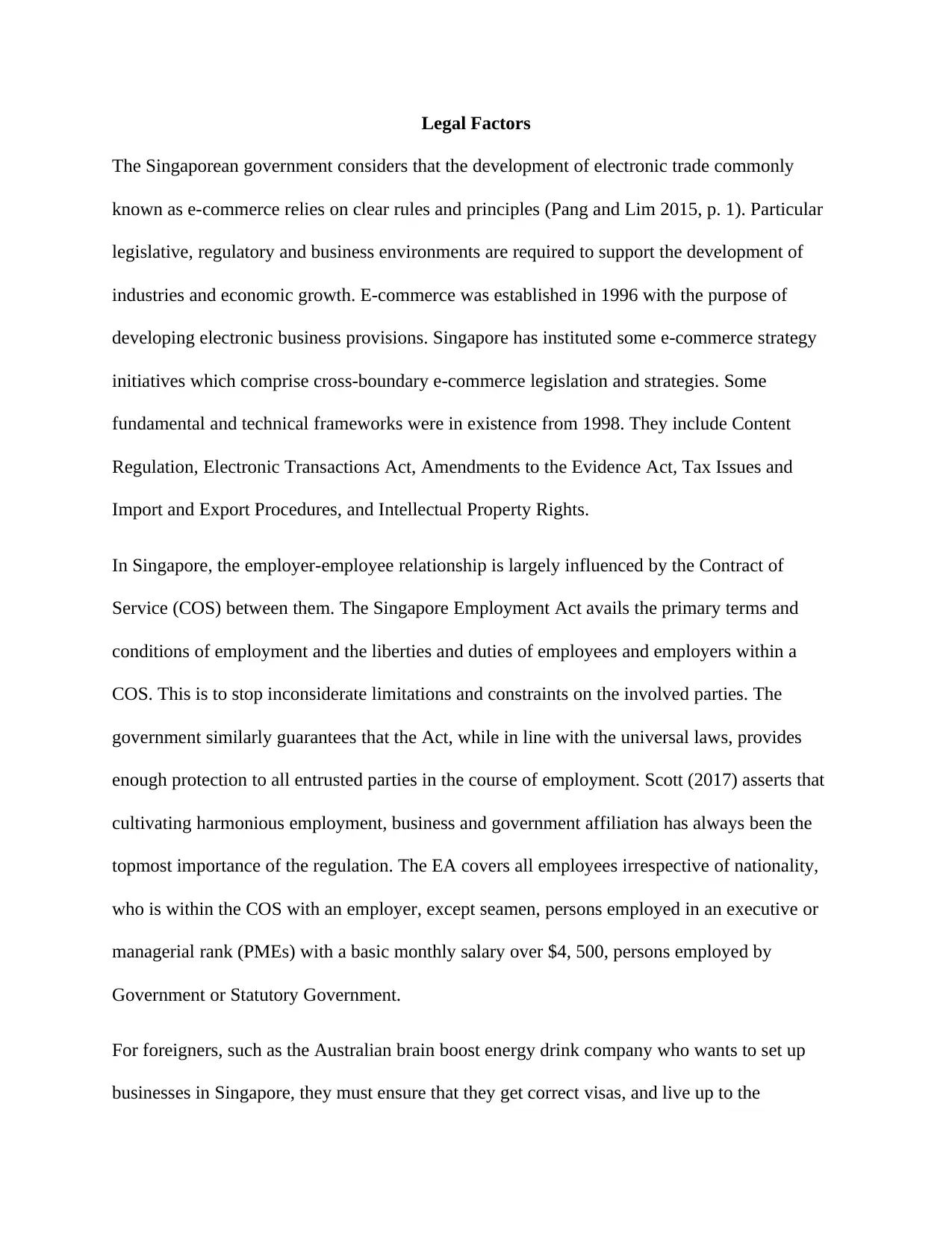
Legal Factors
The Singaporean government considers that the development of electronic trade commonly
known as e-commerce relies on clear rules and principles (Pang and Lim 2015, p. 1). Particular
legislative, regulatory and business environments are required to support the development of
industries and economic growth. E-commerce was established in 1996 with the purpose of
developing electronic business provisions. Singapore has instituted some e-commerce strategy
initiatives which comprise cross-boundary e-commerce legislation and strategies. Some
fundamental and technical frameworks were in existence from 1998. They include Content
Regulation, Electronic Transactions Act, Amendments to the Evidence Act, Tax Issues and
Import and Export Procedures, and Intellectual Property Rights.
In Singapore, the employer-employee relationship is largely influenced by the Contract of
Service (COS) between them. The Singapore Employment Act avails the primary terms and
conditions of employment and the liberties and duties of employees and employers within a
COS. This is to stop inconsiderate limitations and constraints on the involved parties. The
government similarly guarantees that the Act, while in line with the universal laws, provides
enough protection to all entrusted parties in the course of employment. Scott (2017) asserts that
cultivating harmonious employment, business and government affiliation has always been the
topmost importance of the regulation. The EA covers all employees irrespective of nationality,
who is within the COS with an employer, except seamen, persons employed in an executive or
managerial rank (PMEs) with a basic monthly salary over $4, 500, persons employed by
Government or Statutory Government.
For foreigners, such as the Australian brain boost energy drink company who wants to set up
businesses in Singapore, they must ensure that they get correct visas, and live up to the
The Singaporean government considers that the development of electronic trade commonly
known as e-commerce relies on clear rules and principles (Pang and Lim 2015, p. 1). Particular
legislative, regulatory and business environments are required to support the development of
industries and economic growth. E-commerce was established in 1996 with the purpose of
developing electronic business provisions. Singapore has instituted some e-commerce strategy
initiatives which comprise cross-boundary e-commerce legislation and strategies. Some
fundamental and technical frameworks were in existence from 1998. They include Content
Regulation, Electronic Transactions Act, Amendments to the Evidence Act, Tax Issues and
Import and Export Procedures, and Intellectual Property Rights.
In Singapore, the employer-employee relationship is largely influenced by the Contract of
Service (COS) between them. The Singapore Employment Act avails the primary terms and
conditions of employment and the liberties and duties of employees and employers within a
COS. This is to stop inconsiderate limitations and constraints on the involved parties. The
government similarly guarantees that the Act, while in line with the universal laws, provides
enough protection to all entrusted parties in the course of employment. Scott (2017) asserts that
cultivating harmonious employment, business and government affiliation has always been the
topmost importance of the regulation. The EA covers all employees irrespective of nationality,
who is within the COS with an employer, except seamen, persons employed in an executive or
managerial rank (PMEs) with a basic monthly salary over $4, 500, persons employed by
Government or Statutory Government.
For foreigners, such as the Australian brain boost energy drink company who wants to set up
businesses in Singapore, they must ensure that they get correct visas, and live up to the
Paraphrase This Document
Need a fresh take? Get an instant paraphrase of this document with our AI Paraphraser
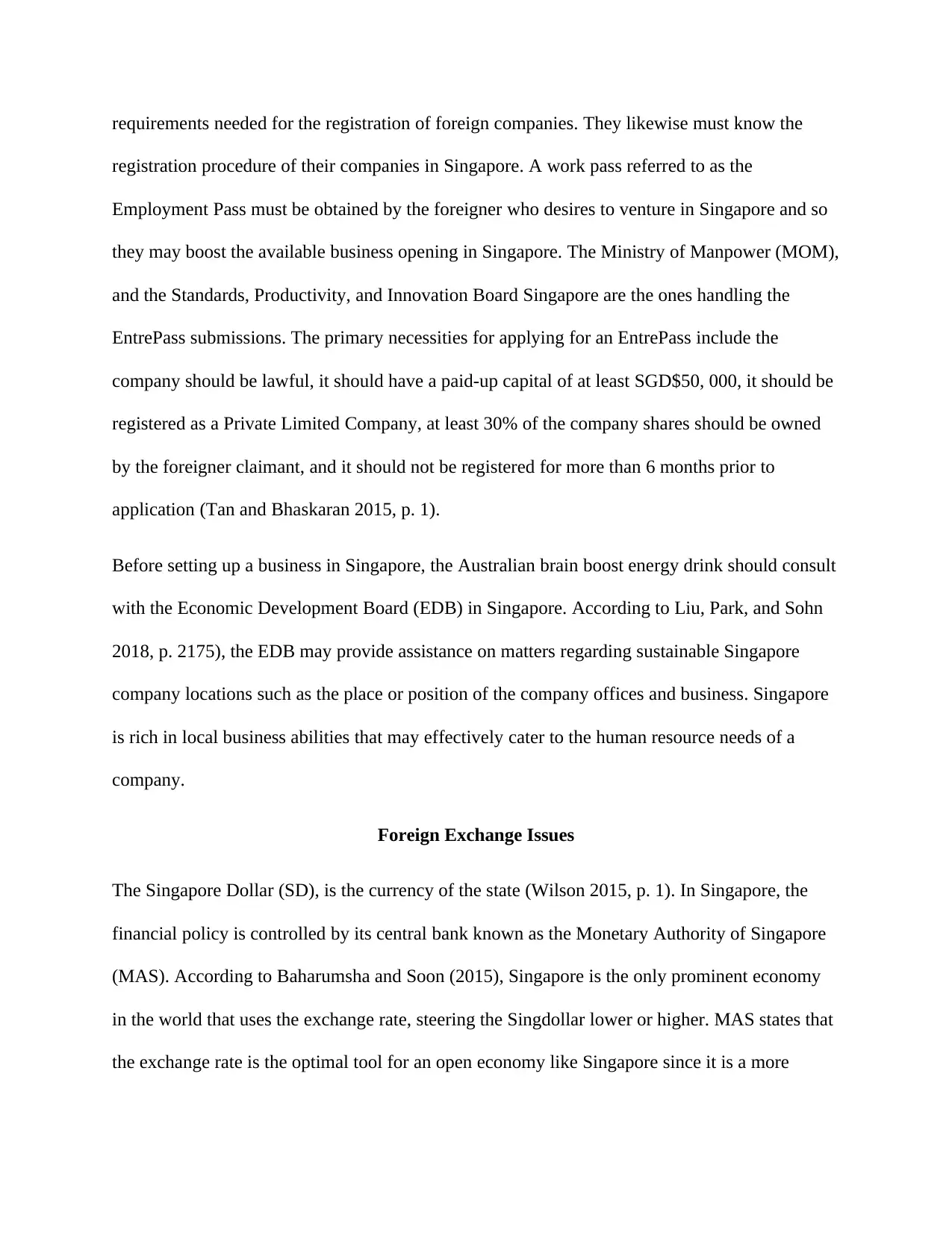
requirements needed for the registration of foreign companies. They likewise must know the
registration procedure of their companies in Singapore. A work pass referred to as the
Employment Pass must be obtained by the foreigner who desires to venture in Singapore and so
they may boost the available business opening in Singapore. The Ministry of Manpower (MOM),
and the Standards, Productivity, and Innovation Board Singapore are the ones handling the
EntrePass submissions. The primary necessities for applying for an EntrePass include the
company should be lawful, it should have a paid-up capital of at least SGD$50, 000, it should be
registered as a Private Limited Company, at least 30% of the company shares should be owned
by the foreigner claimant, and it should not be registered for more than 6 months prior to
application (Tan and Bhaskaran 2015, p. 1).
Before setting up a business in Singapore, the Australian brain boost energy drink should consult
with the Economic Development Board (EDB) in Singapore. According to Liu, Park, and Sohn
2018, p. 2175), the EDB may provide assistance on matters regarding sustainable Singapore
company locations such as the place or position of the company offices and business. Singapore
is rich in local business abilities that may effectively cater to the human resource needs of a
company.
Foreign Exchange Issues
The Singapore Dollar (SD), is the currency of the state (Wilson 2015, p. 1). In Singapore, the
financial policy is controlled by its central bank known as the Monetary Authority of Singapore
(MAS). According to Baharumsha and Soon (2015), Singapore is the only prominent economy
in the world that uses the exchange rate, steering the Singdollar lower or higher. MAS states that
the exchange rate is the optimal tool for an open economy like Singapore since it is a more
registration procedure of their companies in Singapore. A work pass referred to as the
Employment Pass must be obtained by the foreigner who desires to venture in Singapore and so
they may boost the available business opening in Singapore. The Ministry of Manpower (MOM),
and the Standards, Productivity, and Innovation Board Singapore are the ones handling the
EntrePass submissions. The primary necessities for applying for an EntrePass include the
company should be lawful, it should have a paid-up capital of at least SGD$50, 000, it should be
registered as a Private Limited Company, at least 30% of the company shares should be owned
by the foreigner claimant, and it should not be registered for more than 6 months prior to
application (Tan and Bhaskaran 2015, p. 1).
Before setting up a business in Singapore, the Australian brain boost energy drink should consult
with the Economic Development Board (EDB) in Singapore. According to Liu, Park, and Sohn
2018, p. 2175), the EDB may provide assistance on matters regarding sustainable Singapore
company locations such as the place or position of the company offices and business. Singapore
is rich in local business abilities that may effectively cater to the human resource needs of a
company.
Foreign Exchange Issues
The Singapore Dollar (SD), is the currency of the state (Wilson 2015, p. 1). In Singapore, the
financial policy is controlled by its central bank known as the Monetary Authority of Singapore
(MAS). According to Baharumsha and Soon (2015), Singapore is the only prominent economy
in the world that uses the exchange rate, steering the Singdollar lower or higher. MAS states that
the exchange rate is the optimal tool for an open economy like Singapore since it is a more
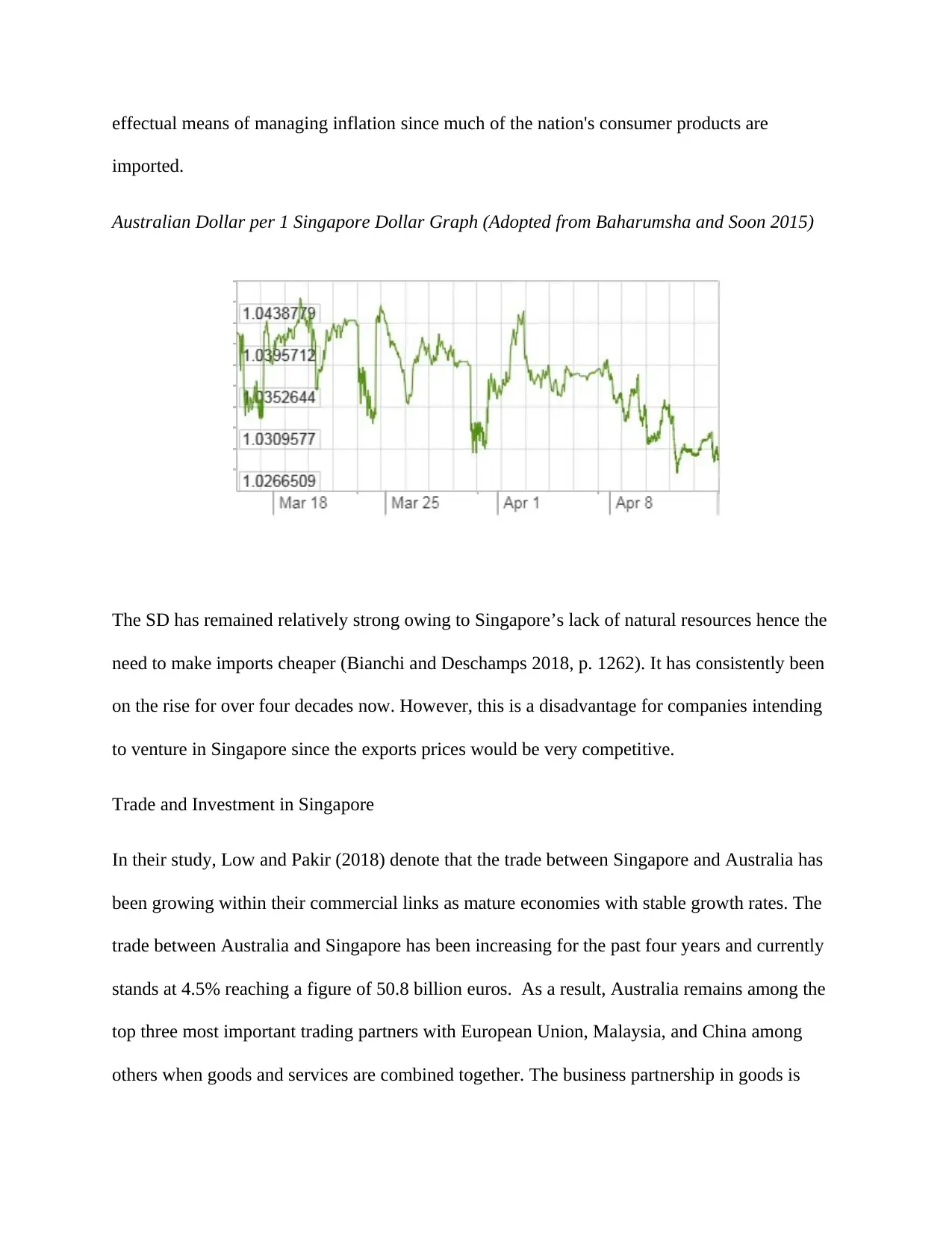
effectual means of managing inflation since much of the nation's consumer products are
imported.
Australian Dollar per 1 Singapore Dollar Graph (Adopted from Baharumsha and Soon 2015)
The SD has remained relatively strong owing to Singapore’s lack of natural resources hence the
need to make imports cheaper (Bianchi and Deschamps 2018, p. 1262). It has consistently been
on the rise for over four decades now. However, this is a disadvantage for companies intending
to venture in Singapore since the exports prices would be very competitive.
Trade and Investment in Singapore
In their study, Low and Pakir (2018) denote that the trade between Singapore and Australia has
been growing within their commercial links as mature economies with stable growth rates. The
trade between Australia and Singapore has been increasing for the past four years and currently
stands at 4.5% reaching a figure of 50.8 billion euros. As a result, Australia remains among the
top three most important trading partners with European Union, Malaysia, and China among
others when goods and services are combined together. The business partnership in goods is
imported.
Australian Dollar per 1 Singapore Dollar Graph (Adopted from Baharumsha and Soon 2015)
The SD has remained relatively strong owing to Singapore’s lack of natural resources hence the
need to make imports cheaper (Bianchi and Deschamps 2018, p. 1262). It has consistently been
on the rise for over four decades now. However, this is a disadvantage for companies intending
to venture in Singapore since the exports prices would be very competitive.
Trade and Investment in Singapore
In their study, Low and Pakir (2018) denote that the trade between Singapore and Australia has
been growing within their commercial links as mature economies with stable growth rates. The
trade between Australia and Singapore has been increasing for the past four years and currently
stands at 4.5% reaching a figure of 50.8 billion euros. As a result, Australia remains among the
top three most important trading partners with European Union, Malaysia, and China among
others when goods and services are combined together. The business partnership in goods is
⊘ This is a preview!⊘
Do you want full access?
Subscribe today to unlock all pages.

Trusted by 1+ million students worldwide
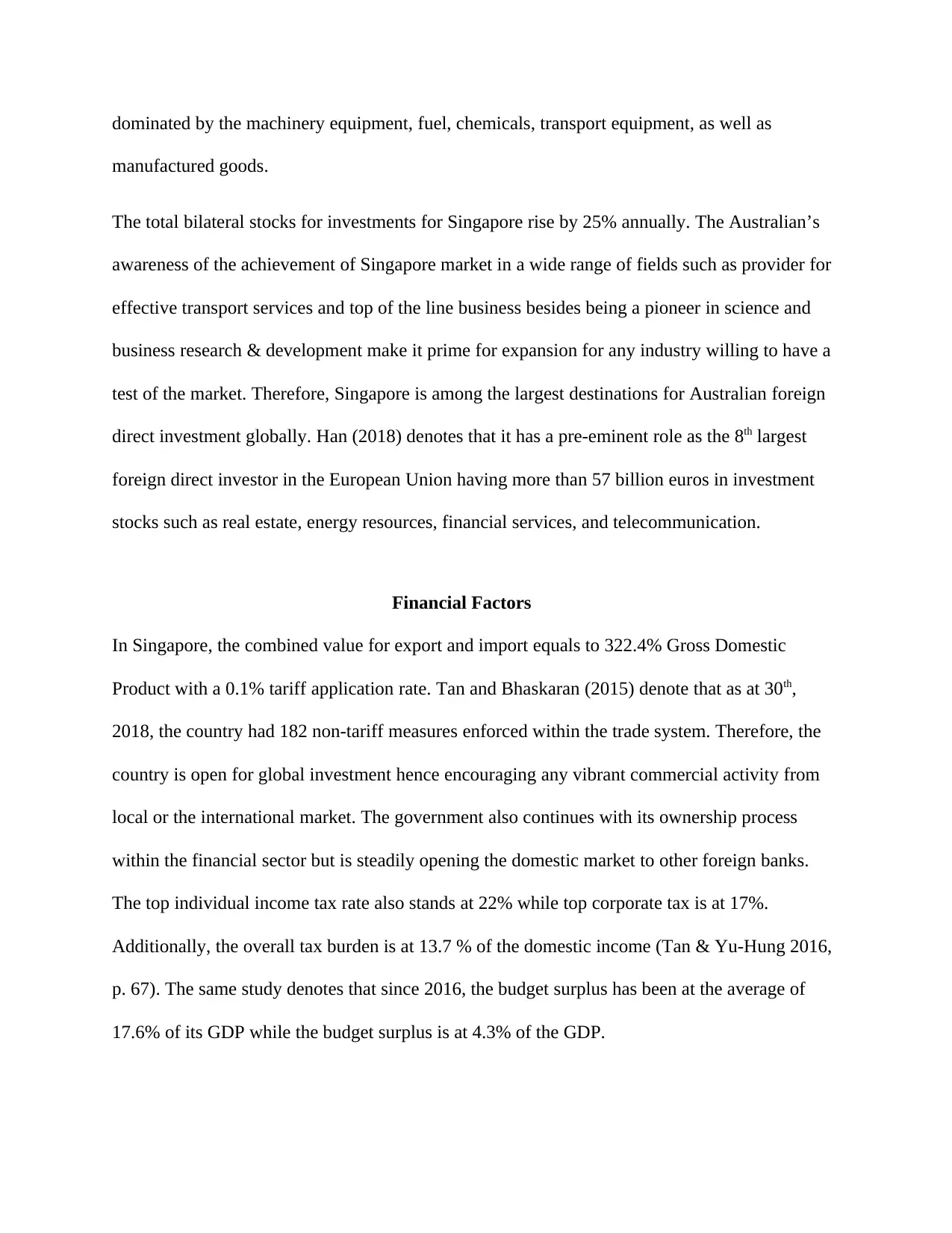
dominated by the machinery equipment, fuel, chemicals, transport equipment, as well as
manufactured goods.
The total bilateral stocks for investments for Singapore rise by 25% annually. The Australian’s
awareness of the achievement of Singapore market in a wide range of fields such as provider for
effective transport services and top of the line business besides being a pioneer in science and
business research & development make it prime for expansion for any industry willing to have a
test of the market. Therefore, Singapore is among the largest destinations for Australian foreign
direct investment globally. Han (2018) denotes that it has a pre-eminent role as the 8th largest
foreign direct investor in the European Union having more than 57 billion euros in investment
stocks such as real estate, energy resources, financial services, and telecommunication.
Financial Factors
In Singapore, the combined value for export and import equals to 322.4% Gross Domestic
Product with a 0.1% tariff application rate. Tan and Bhaskaran (2015) denote that as at 30th,
2018, the country had 182 non-tariff measures enforced within the trade system. Therefore, the
country is open for global investment hence encouraging any vibrant commercial activity from
local or the international market. The government also continues with its ownership process
within the financial sector but is steadily opening the domestic market to other foreign banks.
The top individual income tax rate also stands at 22% while top corporate tax is at 17%.
Additionally, the overall tax burden is at 13.7 % of the domestic income (Tan & Yu-Hung 2016,
p. 67). The same study denotes that since 2016, the budget surplus has been at the average of
17.6% of its GDP while the budget surplus is at 4.3% of the GDP.
manufactured goods.
The total bilateral stocks for investments for Singapore rise by 25% annually. The Australian’s
awareness of the achievement of Singapore market in a wide range of fields such as provider for
effective transport services and top of the line business besides being a pioneer in science and
business research & development make it prime for expansion for any industry willing to have a
test of the market. Therefore, Singapore is among the largest destinations for Australian foreign
direct investment globally. Han (2018) denotes that it has a pre-eminent role as the 8th largest
foreign direct investor in the European Union having more than 57 billion euros in investment
stocks such as real estate, energy resources, financial services, and telecommunication.
Financial Factors
In Singapore, the combined value for export and import equals to 322.4% Gross Domestic
Product with a 0.1% tariff application rate. Tan and Bhaskaran (2015) denote that as at 30th,
2018, the country had 182 non-tariff measures enforced within the trade system. Therefore, the
country is open for global investment hence encouraging any vibrant commercial activity from
local or the international market. The government also continues with its ownership process
within the financial sector but is steadily opening the domestic market to other foreign banks.
The top individual income tax rate also stands at 22% while top corporate tax is at 17%.
Additionally, the overall tax burden is at 13.7 % of the domestic income (Tan & Yu-Hung 2016,
p. 67). The same study denotes that since 2016, the budget surplus has been at the average of
17.6% of its GDP while the budget surplus is at 4.3% of the GDP.
Paraphrase This Document
Need a fresh take? Get an instant paraphrase of this document with our AI Paraphraser
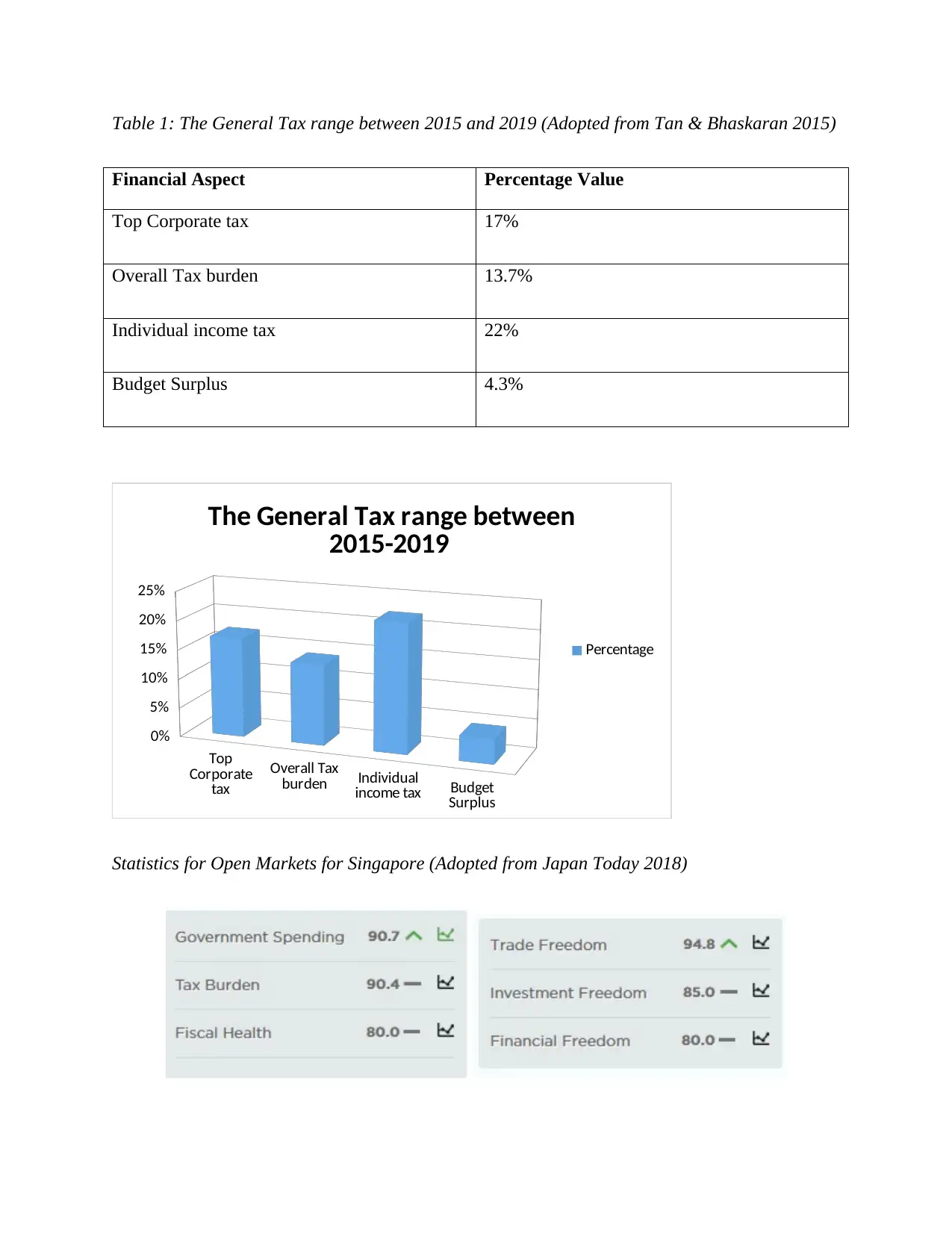
Table 1: The General Tax range between 2015 and 2019 (Adopted from Tan & Bhaskaran 2015)
Financial Aspect Percentage Value
Top Corporate tax 17%
Overall Tax burden 13.7%
Individual income tax 22%
Budget Surplus 4.3%
Top
Corporate
tax
Overall Tax
burden Individual
income tax Budget
Surplus
0%
5%
10%
15%
20%
25%
The General Tax range between
2015-2019
Percentage
Statistics for Open Markets for Singapore (Adopted from Japan Today 2018)
Financial Aspect Percentage Value
Top Corporate tax 17%
Overall Tax burden 13.7%
Individual income tax 22%
Budget Surplus 4.3%
Top
Corporate
tax
Overall Tax
burden Individual
income tax Budget
Surplus
0%
5%
10%
15%
20%
25%
The General Tax range between
2015-2019
Percentage
Statistics for Open Markets for Singapore (Adopted from Japan Today 2018)
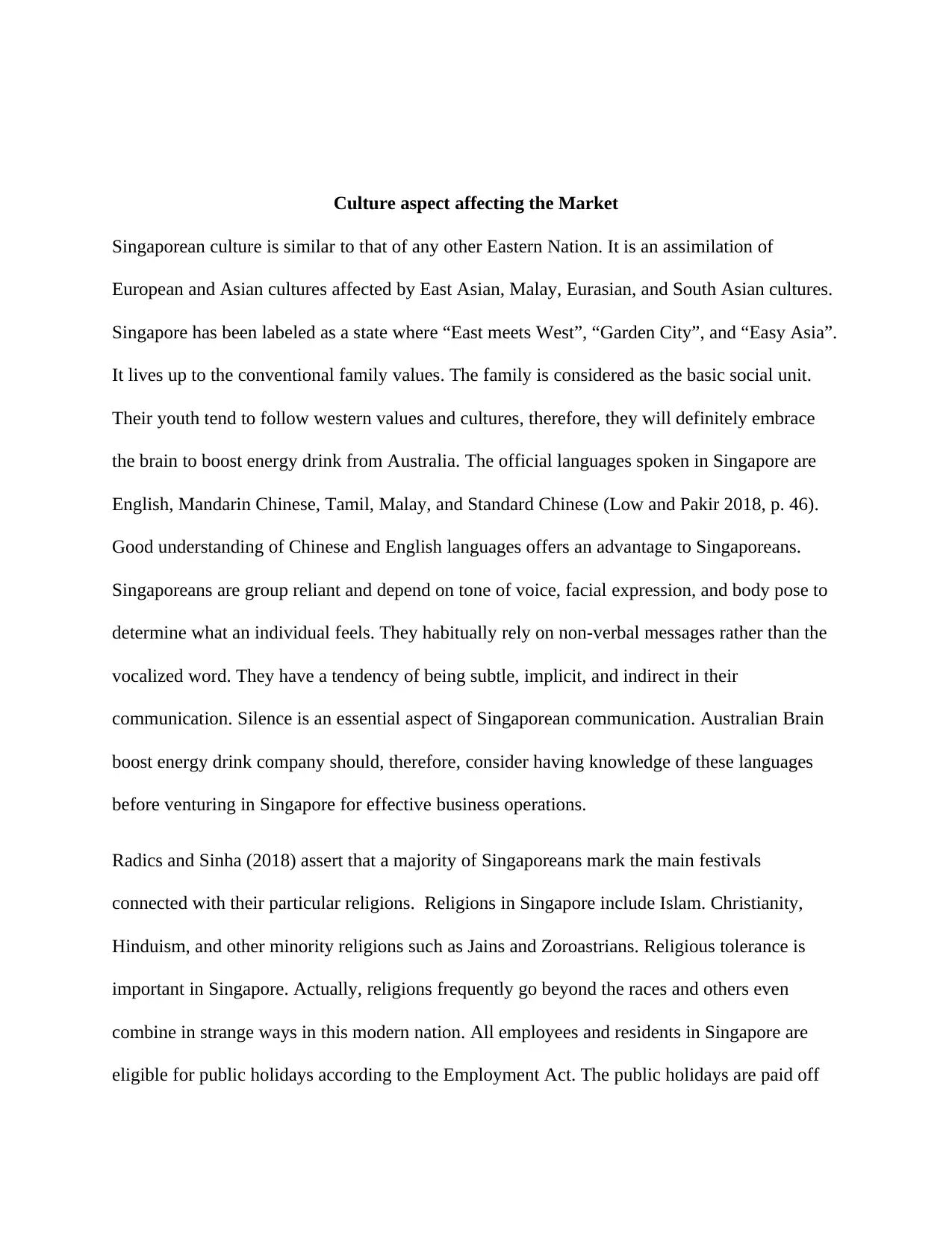
Culture aspect affecting the Market
Singaporean culture is similar to that of any other Eastern Nation. It is an assimilation of
European and Asian cultures affected by East Asian, Malay, Eurasian, and South Asian cultures.
Singapore has been labeled as a state where “East meets West”, “Garden City”, and “Easy Asia”.
It lives up to the conventional family values. The family is considered as the basic social unit.
Their youth tend to follow western values and cultures, therefore, they will definitely embrace
the brain to boost energy drink from Australia. The official languages spoken in Singapore are
English, Mandarin Chinese, Tamil, Malay, and Standard Chinese (Low and Pakir 2018, p. 46).
Good understanding of Chinese and English languages offers an advantage to Singaporeans.
Singaporeans are group reliant and depend on tone of voice, facial expression, and body pose to
determine what an individual feels. They habitually rely on non-verbal messages rather than the
vocalized word. They have a tendency of being subtle, implicit, and indirect in their
communication. Silence is an essential aspect of Singaporean communication. Australian Brain
boost energy drink company should, therefore, consider having knowledge of these languages
before venturing in Singapore for effective business operations.
Radics and Sinha (2018) assert that a majority of Singaporeans mark the main festivals
connected with their particular religions. Religions in Singapore include Islam. Christianity,
Hinduism, and other minority religions such as Jains and Zoroastrians. Religious tolerance is
important in Singapore. Actually, religions frequently go beyond the races and others even
combine in strange ways in this modern nation. All employees and residents in Singapore are
eligible for public holidays according to the Employment Act. The public holidays are paid off
Singaporean culture is similar to that of any other Eastern Nation. It is an assimilation of
European and Asian cultures affected by East Asian, Malay, Eurasian, and South Asian cultures.
Singapore has been labeled as a state where “East meets West”, “Garden City”, and “Easy Asia”.
It lives up to the conventional family values. The family is considered as the basic social unit.
Their youth tend to follow western values and cultures, therefore, they will definitely embrace
the brain to boost energy drink from Australia. The official languages spoken in Singapore are
English, Mandarin Chinese, Tamil, Malay, and Standard Chinese (Low and Pakir 2018, p. 46).
Good understanding of Chinese and English languages offers an advantage to Singaporeans.
Singaporeans are group reliant and depend on tone of voice, facial expression, and body pose to
determine what an individual feels. They habitually rely on non-verbal messages rather than the
vocalized word. They have a tendency of being subtle, implicit, and indirect in their
communication. Silence is an essential aspect of Singaporean communication. Australian Brain
boost energy drink company should, therefore, consider having knowledge of these languages
before venturing in Singapore for effective business operations.
Radics and Sinha (2018) assert that a majority of Singaporeans mark the main festivals
connected with their particular religions. Religions in Singapore include Islam. Christianity,
Hinduism, and other minority religions such as Jains and Zoroastrians. Religious tolerance is
important in Singapore. Actually, religions frequently go beyond the races and others even
combine in strange ways in this modern nation. All employees and residents in Singapore are
eligible for public holidays according to the Employment Act. The public holidays are paid off
⊘ This is a preview!⊘
Do you want full access?
Subscribe today to unlock all pages.

Trusted by 1+ million students worldwide
1 out of 20
Related Documents
Your All-in-One AI-Powered Toolkit for Academic Success.
+13062052269
info@desklib.com
Available 24*7 on WhatsApp / Email
![[object Object]](/_next/static/media/star-bottom.7253800d.svg)
Unlock your academic potential
Copyright © 2020–2025 A2Z Services. All Rights Reserved. Developed and managed by ZUCOL.





